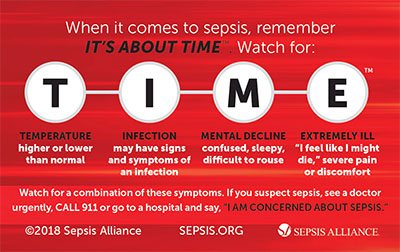Every 20 seconds, someone in the U.S. is diagnosed with sepsis, a potentially life-threatening condition caused by the body’s response to an infection. In fact, annual mortality from sepsis in the U.S. rivals deaths from prostate cancer, breast cancer and AIDS combined. While early action and treatment can reduce the sepsis mortality rate, many aren’t aware of the signs and symptoms.1
BD has joined forces with Sepsis Alliance, the U.S.’s first and leading nonprofit sepsis organization. Sepsis Alliance is working to save lives and bring together health care professionals (HCPs) in the fight against sepsis. Through our support of Sepsis Awareness Month, World Sepsis Day and other initiatives, we are working together to advance sepsis education and promote the critical need to seek treatment when symptoms are recognized. BD is also a supporter of the Sepsis Coordinator Network, a community created and led by Sepsis Alliance’s interdisciplinary team of experts, which aims to foster collaboration and facilitate sharing of tools and resources among the health care community.
While sepsis remains a leading cause of death, it is also the most expensive in-patient cost at hospitals in the U.S. costing $24 billion per year. 1,2 At BD, we are focused on a full sepsis solution, including education, prevention, diagnosis and treatment. Our sepsis management program helps HCPs accurately identify patients at risk for sepsis and those with bloodstream infections. Time is critical for these patients in order to provide the most effective sepsis treatment. The goals of our program aim to:
- Reduce time to identification of patients at risk for sepsis, detection, laboratory turnaround time and time to appropriate therapy
- Improve collection of appropriate blood culture volumes and optimize diagnostic accuracy
- Improve patient outcomes
This World Sepsis Day learn more about how the BD® Sepsis Management program is helping clinicians set patients at risk for sepsis on the right path from early recognition of symptoms through treatment of the condition.
Subscribe to receive BD blog alerts
